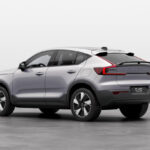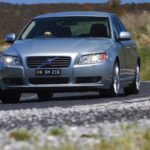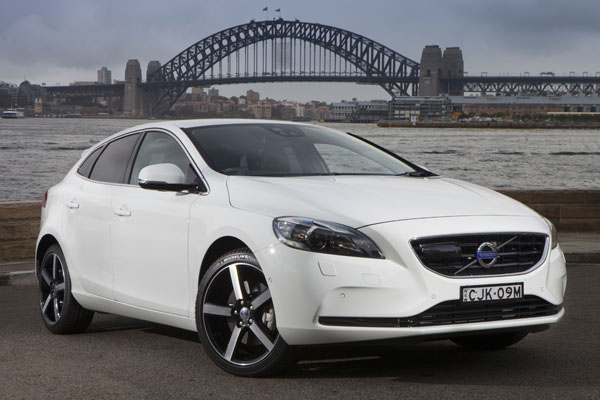
Volvos are far more stylish now than in the past and the new V40 really excels in this important area
The all-new Volvo V40 takes the premium hatchback to a new level. As well as arguably being the most stylish Volvo for many years, it’s undoubtedly the most intelligent and safe car in its segment. Indeed it can show many far more expensive cars a thing or two in these important fields.
As well as the sleek body, Scandinavian simplicity and ergonomic design abound in the Volvo V40’s cabin. The T5 we borrowed for a week had quality materials on sculpted R-Design sports seats with contrasting stitching; gearshift knob LED-illuminated from the inside and LEDs in the door panel storage pockets. If there’s anything we didn’t like it was the over-abundance of black inside our test car.
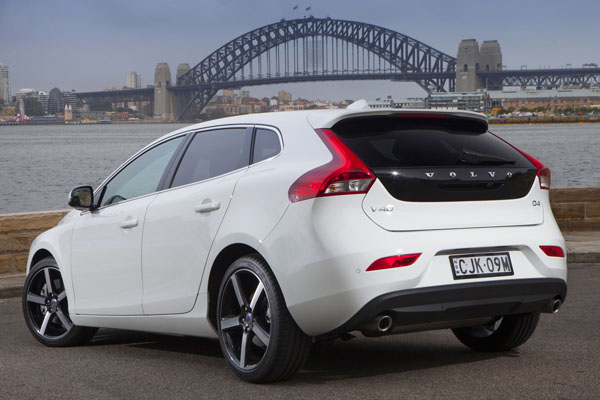
The low roofline will have most occupants ducking to get in and out. A panoramic sunroof limits headroom. Legroom in the rear is adequate and shoulder space not overly cramped for three people of average build.
The innovative Volvo Sensus infotainment system, in which information is presented on a five- or seven-inch colour screen depending on the model, in the upper instrument panel, makes it easy for the driver to keep his or her eyes on the road. All functions can be operated from the steering wheel or via controls located directly below the screen.
Volvo My Car allows access to a wide range of settings, such as for City Safety, Collision Warning, Pedestrian Detection, Driver Alert System, Active Cruise Control, lighting, door mirrors, climate unit, central locking and the audio system.
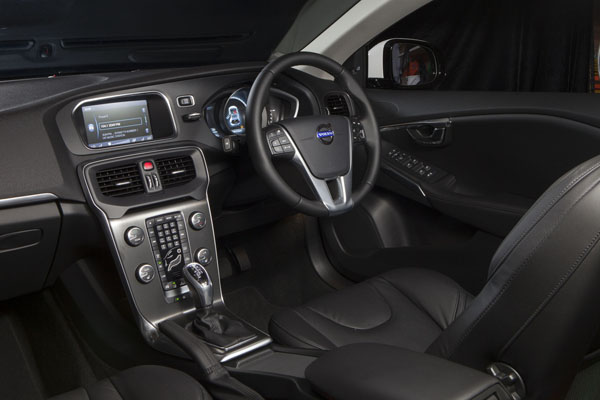
With the optional multimedia audio system, Volvo Sensus comes upgraded with a seven-inch screen that also displays information and images from the navigation system, phone, reversing camera, DVD player and more.
A new digital instrument cluster directly in front of the driver uses a TFT (Thin Film Transistor) crystal display to present the most important information in any situation.
The driver can choose between three graphic themes: Elegance, a traditional amber illumination; Eco, a green background illumination, designed to create an environmentally-inspired look. An Eco meter, plus current and accumulated fuel consumption figures are displayed. The driver gets a green light when eco-driving is optimal.
The third theme, Performance, provides a sporting red background illumination.
Vehicle speed is shown digitally in the centre of the display. The right display includes a power meter – a gauge that informs the driver how much power is available and how much power is being used at any time.
Below the armrest is a storage compartment suitable for CDs and other small items, while the glove compartment includes space for two cans or bottles. The latter are cooled by air from the climate control system.
A major new safety feature is a world-first pedestrian airbag technology. Most serious head injuries involving pedestrians are caused by the hard structure directly under the bonnet, the lower edge of the windscreen and the windscreen pillars.
Seven sensors in the front of the new Volvo V40 transmit signals to a control unit. When the car hits an object, the signals change, and if the car thinks the object is a human leg the pedestrian protection system reacts.
The bonnet rear hinges are released and the bonnet lifts to get it away from the hard surfaces under it. The pedestrian airbag is activated. The airbag covers the entire windscreen wiper recess, about a third of the windscreen and the lower part of the A-pillars.
Before this amazing technology springs into action, the V40 has already done its best to avoid the collision. The car ‘looks’ down for pedestrians and other risks and if need be applies full auto braking. This is part of the existing Volvo City Safety system and in its latest development it operates to avoid, or at least minimise, collisions at speeds up to 50 km/h.
Keeping the car out of trouble are lane keeping aid with automatic steering, automatic road sign Information, park assist, active high beam headlights and a cross traffic alert radar system. These aren’t all standard in every model, contact your Volvo dealer for full specifications and optional charges.
This high-performance Volvo V40 T5 R-design can cover the zero to 100 km/h acceleration test in just 6.1 seconds thanks to its five-cylinder 2.5-litre turbocharged engine putting out 187 kW of power and 360 Nm of torque.
Interestingly, this powerplant is a relative of that used in the latest Ford Falcon with EcoBoost and there’s speculation Ford Australia may bring out a high-performance Falcon using an adaptation of the Volvo five-cylinder unit.
In the R-Design Volvo the engine drives though a six-speed Geartronic automatic transmission, with a manual mode for sporting occasions. We feel it should have steering wheel paddles to add to the excitement.
The Volvo has smooth acceleration thanks not only to the design of the engine, but also because of impressively fast gear shifts.
Steering is direct and produces positive feedback of the type that’s enjoyed by enthusiastic drivers.
The Sport chassis, standard on the T5 R-Design, is 10 mm lower than the standard set-up. Springs and shock absorbers have a firmer setting, resulting in extra-responsive driving with sharper control.
Steering has electrical power assistance and can be optioned in three ways: City, with a high degree of power support for easy manoeuvring; Normal offers more road response at higher speeds; and Sport, adds a dynamic character. Thank goodness for the body-hugging sports-style seats as it grips hard in all modes.
The stiffer suspension works well on better bitumen surfaces, but supplies a harsh ride on surfaces that have seen better days. Recent heavy rain on the Gold Coast didn’t do the test car any favours, with pot holes and washouts jolting the body all too frequently.
With a large C-pillar and small rear window reversing could be hazardous but for assistance from sensors all round the car.
Auto dimming headlamps reduce glare for oncoming traffic, cornering lights are controlled by steering input.
Daytime running lights, a safety feature invented by Volvo decades before the rest of the world caught onto the idea, provide improved visibility of the V40 to all other road users, be they drivers or pedestrians.
Volvo Cars is working towards its vision that by 2020, nobody should be killed or seriously injured in a new Volvo. A seemingly impossible target to our way of thinking, but the V40 certainly showcases the incredible amount of intelligent thinking the Swedish marque continues to put into safety.
AT A GLANCE
MODEL RANGE
V40 D2 Kinetic 1.6-litre turbo-diesel five-door wagon: $34,990 (manual)
V40 D4 Kinetic 2.0-litre turbo-diesel five-door wagon: $39,990 (manual)
V40 D4 Kinetic 2.0-litre turbo-diesel five-door wagon: $41,990 (automatic) V40 D4 Luxury 2.0-litre turbo-diesel five-door wagon: $45,990 (automatic)
V40 T4 Kinetic 2.0-litre turbo-petrol five-door wagon: $41,990 (automatic) V40 T4 Luxury 2.0-litre turbo-petrol five-door wagon: $45,990 (automatic) V40 T5 R-Design 2.5-litre turbo-petrol five-door wagon: $49,990 (automatic)
Note: These prices do not include government or dealer delivery charges. Contact your local Volvo dealer for drive-away prices.
SPECIFICATIONS (Volvo V40 T5 R-Design 2.5-litre turbo-petrol five-door wagon)
ENGINE
Capacity: 2497 cc
Configuration: In-line five-cylinder, DOHC, four valves per cylinder, turbocharged petrol
Location: Front, transverse
Maximum Power: 187 kW @ 5400 rpm
Maximum Torque: 360 Nm @ 1800-4200 rpm
DRIVELINE:
Driven wheels: Front
Transmission: Six-speed Geartronic automatic with Neutral Control and Sports mode
DIMENSIONS, WEIGHT AND CAPACITIES:
Turning circle: 11.7 m
Kerb weight: 1468 kg
Fuel tank capacity: 62 litres
PERFORMANCE:
Acceleration 0-100 km/h: 6.1 sec
Maximum speed: 250 km/h
FUEL CONSUMPTION:
Combined Cycle (ADR 81/01): 8.1 L/100 km, CO2 emissions 189 g/km
SUSPENSION AND BRAKES:
Front Suspension: MacPherson strut. Anti-dive anti-lift function with anti-roll bars
Rear Suspension: Multilink independent . Anti-dive anti-lift function with anti-roll bars
Brakes: Ventilated discs (front); ABS with Brake Assist (BA), Electronic Brakeforce Distribution (EBD), Traction Control (TRC), Vehicle Stability Control (VSC)
Steering: Electric power assisted
Wheels: Alloy 7.5 x 18-inch IXION II R-Design
GREEN VEHICLE GUIDE RATINGS:
Greenhouse Rating: 6.5 / 10
Air Pollution Rating: 7.5 / 10




